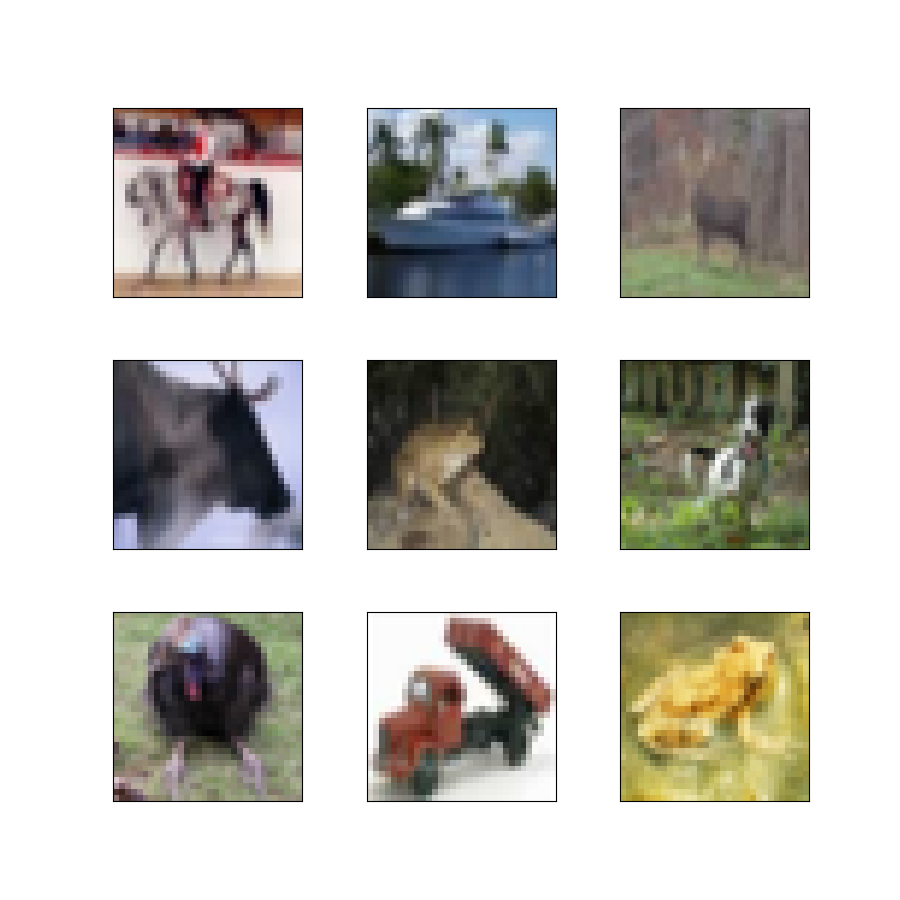- 説明:
CIFAR-10 の再ラベル付けされたバージョンで、実際の人間による注釈エラーがあります。元の CIFAR-10 トレイン セットのすべてのペア (画像、ラベル) に対して、実際の人間のアノテーターによって付けられたいくつかの追加ラベルが提供されます。
バージョン:
-
1.0.0: 初期リリース。 -
1.0.1:worse_labelキーのタイプミスを修正しました。 -
1.0.2: 注釈と画像の対応を修正しました。 -
1.0.3:MANUAL_DIRのファイルを修正。 -
1.0.4(デフォルト): サイド情報の読み込みを修正しました。
-
ダウンロードサイズ:
162.17 MiBデータセットサイズ:
147.91 MiB手動ダウンロードの手順: このデータセットでは、ソース データを手動で
download_config.manual_dir(デフォルトは~/tensorflow_datasets/downloads/manual/) にダウンロードする必要があります。
https://github.com/UCSC-REAL/cifar-10-100nから「side_info_cifar10N.csv」、「CIFAR-10_human_ordered.npy」、「image_order_c10.npy」をダウンロードします
次に、「CIFAR-10_human_ordered.npy」を CSV ファイル「CIFAR-10_human_annotations.csv」に変換します。これは、次のコードで実行できます。
import numpy as np
from tensorflow_datasets.core.utils.lazy_imports_utils import pandas as pd
from tensorflow_datasets.core.utils.lazy_imports_utils import tensorflow as tf
human_labels_np_path = '<local_path>/CIFAR-10_human_ordered.npy'
human_labels_csv_path = '<local_path>/CIFAR-10_human_annotations.csv'
with tf.io.gfile.GFile(human_labels_np_path, "rb") as f:
human_annotations = np.load(f, allow_pickle=True)
df = pd.DataFrame(human_annotations[()])
with tf.io.gfile.GFile(human_labels_csv_path, "w") as f:
df.to_csv(f, index=False)
自動キャッシュ(ドキュメント): はい
スプリット:
| スプリット | 例 |
|---|---|
'test' | 10,000 |
'train' | 50,000 |
- 機能構造:
FeaturesDict({
'aggre_label': ClassLabel(shape=(), dtype=int64, num_classes=10),
'id': Text(shape=(), dtype=string),
'image': Image(shape=(32, 32, 3), dtype=uint8),
'label': ClassLabel(shape=(), dtype=int64, num_classes=10),
'random_label1': ClassLabel(shape=(), dtype=int64, num_classes=10),
'random_label2': ClassLabel(shape=(), dtype=int64, num_classes=10),
'random_label3': ClassLabel(shape=(), dtype=int64, num_classes=10),
'worker1_id': int64,
'worker1_time': float32,
'worker2_id': int64,
'worker2_time': float32,
'worker3_id': int64,
'worker3_time': float32,
'worse_label': ClassLabel(shape=(), dtype=int64, num_classes=10),
})
- 機能のドキュメント:
| 特徴 | クラス | 形 | Dtype | 説明 |
|---|---|---|---|---|
| 特徴辞書 | ||||
| aggre_label | クラスラベル | int64 | ||
| ID | 文章 | ストリング | ||
| 画像 | 画像 | (32, 32, 3) | uint8 | |
| ラベル | クラスラベル | int64 | ||
| random_label1 | クラスラベル | int64 | ||
| random_label2 | クラスラベル | int64 | ||
| random_label3 | クラスラベル | int64 | ||
| worker1_id | テンソル | int64 | ||
| worker1_time | テンソル | float32 | ||
| worker2_id | テンソル | int64 | ||
| worker2_time | テンソル | float32 | ||
| worker3_id | テンソル | int64 | ||
| worker3_time | テンソル | float32 | ||
| より悪い_ラベル | クラスラベル | int64 |
監視されたキー(
as_superviseddocを参照):None図( tfds.show_examples ):

- 例( tfds.as_dataframe ):
- 引用:
@inproceedings{wei2022learning,
title={Learning with Noisy Labels Revisited: A Study Using Real-World Human
Annotations},
author={Jiaheng Wei and Zhaowei Zhu and Hao Cheng and Tongliang Liu and Gang
Niu and Yang Liu},
booktitle={International Conference on Learning Representations},
year={2022},
url={https://openreview.net/forum?id=TBWA6PLJZQm}
}

